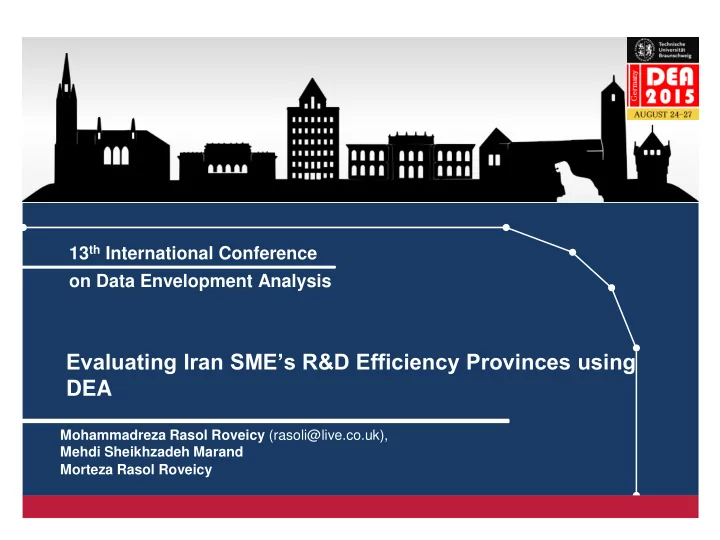

13 th International Conference on Data Envelopment Analysis Evaluating Iran SME’s R&D Efficiency Provinces using DEA Mohammadreza Rasol Roveicy (rasoli@live.co.uk), Mehdi Sheikhzadeh Marand Morteza Rasol Roveicy
Objective of the paper This paper aims to compare the relative efficiency of SME’s R&D (now called as knowledge-based firms) across different provinces of Iran. In this study we define an individual R&D efficiency of a single output known as R&D projects completed in the respected province of Iran. 13 th International Conference on Data Envelopment Analysis 2015 | Page 2
Methodology & Data In this study , we use BCC model or VRS Input- Oriented DEA. The BCC model by Banker, Charnes & Cooper (1984) is a well-known DEA model; it has almost all of the characteristics of the earlier CCR model. However, unlike the CCR Model, the BCC Model enables the problem to be variable-returns-to- scale. This property is assured through a convexity constraint, which makes the production frontier to be spanned by the DMU a convex hull. 13 th International Conference on Data Envelopment Analysis 2015 | Page 3
Data Compilation The data utilized in this study make up a panel dataset of 31 provinces providing R&D activities in the year 2010. Inputs consisting number of R&D personnel, R&D personnel per capita expenditure, average per capita capital expenditure and R&D projects completed as an output . The data has been provided by Statistical center of Iran. 13 th International Conference on Data Envelopment Analysis 2015 | Page 4
Estimation of efficiency scores using BCC Model Table 1 displays the results of each SME’s R&D province using BCC model in the period 2010.Among 31 provinces only 8 provinces scoring 100% efficiency with constant return to scale while the remaining 23 provinces reported as an efficient unit all exhibiting decreasing return to scale . Table 1 indicates the best and worst efficiency in SME’s R&D provinces of Iran ranging from 100% to 7.04%.Each an inefficient SME’s R&D provinces has got its peer as an efficient unit .For example ,Alborz province with 28.18% efficiency score has got 2 province namely Tehran and Northern Khorasan as peer or reference set . 13 th International Conference on Data Envelopment Analysis 2015 | Page 5
Analysis of reference set in respect to input-output contribution One of most valuable analysis in Data envelopment Analysis is the comparison of an inefficient DMU with its counterpart as peer or reference set. Though, Kermanshah has 3 reference set or peer here we focus mainly on the SME’s R&D of Kurdistan province as a peer for comparison to save space. But to decide which reference set to is choose then input- output contribution comes to help. The best practice by which an inefficient unit can improve through reference set or peers which are 100% efficient. It is that an inefficient unit’s reference set contains the efficient units which have the most similar input/output orientation to itself and they should therefore provide examples of good operating practice for it to emulate. 13 th International Conference on Data Envelopment Analysis 2015 | Page 6
Reference contribution of 4 efficient SME’s R&D 13 th International Conference on Data Envelopment Analysis 2015 | Page 7
Efficiency Scores for SME’s R&D provinces of Iran 13 th International Conference on Data Envelopment Analysis 2015 | Page 8
Reference Comparison of Kermanshah R&D 13 th International Conference on Data Envelopment Analysis 2015 | Page 9
Concluding remarks In this paper efficiency of 31 SME’s R&D provinces have been examined applying BCC-Input oriented DEA model. The only available data available surveyed by the statistical center of Iran was 2010.The results obtained from BCC-Input oriented DEA model along with information on input-output contribution of most efficient DMU as a peer, it is to conclude that SME’s R&D province of Kermanshah to be efficient and to lie on frontier line it must emulate its reference set input-output contribution i.e. SME’s R&D province of Kurdistan . Based upon results obtained Since most of the SME’s R&D provinces of Iran(23 SME’s R&D) exhibiting decreasing return to scale and because of uneven distribution of resources across provinces it is suggested that to emulate the reference set which corresponds with each inefficient units. Further, in order to have updated result it is highly recommended to revise the inputs(revised compilation of data is required) according to the data set published by international organizations. Further study is needed to reach the definite and desirable result and determination of causes this uneven distribution of resources across provinces must be undertaken- among to mention is TOPSIS. 13 th International Conference on Data Envelopment Analysis 2015 | Page 11
13 th International Conference on Data Envelopment Analysis 2015 | Page 12
Recommend
More recommend